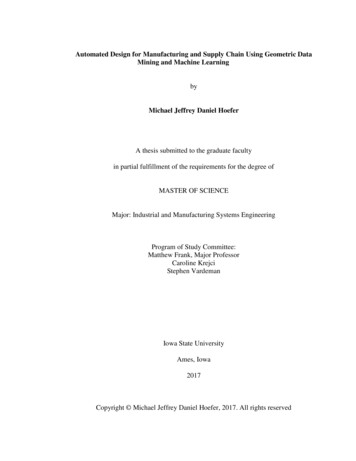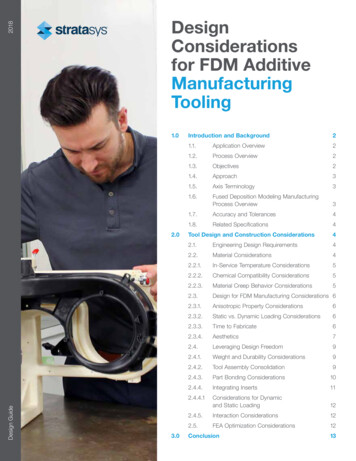
Transcription
Automated Design for Manufacturing and Supply Chain Using Geometric DataMining and Machine LearningbyMichael Jeffrey Daniel HoeferA thesis submitted to the graduate facultyin partial fulfillment of the requirements for the degree ofMASTER OF SCIENCEMajor: Industrial and Manufacturing Systems EngineeringProgram of Study Committee:Matthew Frank, Major ProfessorCaroline KrejciStephen VardemanIowa State UniversityAmes, Iowa2017Copyright Michael Jeffrey Daniel Hoefer, 2017. All rights reserved
iiTABLE OF CONTENTSPageACKNOWLEDGEMENTS . iiiABSTRACT. ivCHAPTER 1: INTRODUCTION . 1Research Motivation . 1Thesis Organization . 6References . 6CHAPTER 2: LITERATURE REVIEW . 7Automated Design for Manufacture . 7Design for Supply Chain . 9References . 12CHAPTER 3: AUTOMATED MANUFACTURING PROCESS SELECTIONDURING CONCEPTUAL DESIGN . 15Abstract . 151. Introduction . 162. Related Work . 183. Automated Process Selection. 203.1 Solution Overview . 203.2 Metrics . 213.3 Machine Learning for Process Selection . 364. Results and Discussion . 395. Conclusions and Future Work . 42References . 46CHAPTER 4: GENERAL CONCLUSIONS AND FUTURE WORK . 51Conclusions . 51Future Work . 52
iiiACKNOWLEDGEMENTSThis work in this thesis would not have been possible without the support of my friends,family, colleagues, and mentors. First, I want to thank my advisor, Dr. Matthew Frank, for hisexceptional guidance and mentoring throughout graduate school. Next, I would like to thankmy graduate committee members, Dr. Caroline Krejci and Dr. Stephen Vardeman, for theirvaluable perspective and insights.I want to thank Dr. Frank Peters, Dr. Michael Dorneich, Dr. John Jackman, and the restof the IMSE faculty from whom I have learned much about research and engineering. I owe alarge thank you to the IMSE staff, as well as the research group in the Rapid Manufacturingand Prototyping Lab for their help and contributions. Finally, I want to thank my parents, Jeffand Diane, siblings, Lea and Jake, and friends who have provided constant encouragementthroughout my time in graduate school.
ivABSTRACTThis thesis presents an automated method for assessing conceptual designs with respectto manufacturing and supply chain, using geometric data mining and machine learningalgorithms. It is important for designers to understand how design decisions will impactdownstream manufacturing and sourcing. Many critical decisions are made during conceptualdesign that impact production cost even before detailed design is finalized; however, the effectsof these decisions are not known until later. Design for manufacturing and design for supplychain are methods that provide feedback to the user in a way that enables proactive designchanges.A conceptual design is largely defined by the geometry found in CAD files. In thiswork, feature-free geometric algorithms were used to extract meaningful manufacturabilitymetrics from 3D models, which were classified as either castings or machined parts. Thedeveloped metrics serve as useful attributes for a machine learning model that can help selectthe manufacturing process of a conceptual design. A classification accuracy of 86% wasachieved using a random forest algorithm, which is comparable to other approaches in theliterature, while only using geometry as input. The work in this thesis provides methods forusing geometry to evaluate a design for manufacturability and supply chain, enabling proactivedesign decisions early during new product development.
1CHAPTER 1: INTRODUCTIONResearch MotivationDesign decisions made during new product development significantly impact thedownstream manufacturing systems and supply chains and therefore limit the profitability ofthe manufacturing systems that produce the designs. The complete details of a new product isprovided in a Technical Data Package referred to as the TDP (Figure 1), which is defined as“a technical description of an item adequate for supporting an acquisition strategy, production,engineering, and logistics support [1].” New product development starts with conceptualdesign, where the general part geometry and schema of a design is determined. However, manydetails in the technical data package, such as quality assurance provisions and geometricdimensioning and tolerancing (GD&T) are still unknown. After conceptual design, detaileddesign seeks to fill out the TDP, resulting in all the information necessary to bring a design tofruition.Technical Data Package (TDP)Design GeometryTestingRequirements.Material SpecsGD&T CalloutsQuality AssuranceProvisionsPackaging Details.Figure 1. Design information included in the technical data package.After the TDP is complete, firms will manufacture, distribute, and sell the product(Figure 2). It has been shown that only 20% of the avoidable cost of the product is due todecisions made by production engineering and 30% of the cost is due to detailed design.However, 50% of the avoidable cost in a product is due to design schemes, such as those
2determined during conceptual design [2]. The ability to predict how a design will impactmanufacturing and the supply chain would enable proactive decisions early during new productdevelopment; however, it is not clearly understood how early design decisions impactdownstream production activities [3].DesignManufactureDistributeand SellFigure 2. Product development cycle.Traditionally, the downstream activity of manufacturing alone was of primary concern. If therewas difficulty in manufacturing, engineering change requests would be considered; however,engineering change requests are costly and can disrupt other parts of the manufacturing system.The practice of design for manufacture (DFM) and design for assembly (DFA) arose as amethod of measuring the manufacturability of a design [4], defined as the ease at which adesign can be produced using a given manufacturing process. DFM enabled designers to makeproactive decisions to increase manufacturability, which became a consideration in addition toperformance(Figure3).Themethods of DFM and DFA can beDesign forPerformancegeneralized to design for “X”(DFX), which also includes designforquality,reliability,maintenance, environment, andlife cycle cost, to name a few [3].ManufactureDistributeand SellDesign forManufactureFigure 3. Product lifecycle including design for manufacture.
3As product complexity rose, firms started to outsource fabrication to suppliers thatspecialize in certain manufacturing processes (Figure 4). Instead of manufacturing eachindividual part, firms source parts through complex global supply chains. Different designsyielddifferentprices,lead times, and ptance rates fromDistributeand SellOut Sourcesuppliers in the supplyFigure 4. Product development cycle with outsourcing.chain. It is expected thatsome of these supply chain impacts are a result of the design of the product being sourced [5].Supply chain management is now a more critical downstream activity. Design decisions affectthe sourceability of a design (Figure 5), which is a general term that is defined as the ease atwhich a product can beSourceabilitysourced from a givensupplychain,withrespect to lead time,quality,ManufacturabilityCostQualityLead TimeRiskSocial Impactcost,.environmentaland more.impact,Figure 5. Elements of the sourceability of a design.Design for supply chain (DFSC) is a relatively new method of measuring thesourceability of a design during product development, and providing feedback that enablesproactive design decisions that improve aspects of supply chain management [6]. For example,if a design is identified early as requiring a forging manufacturing process, economicconsiderations around the forging industry may drive the design towards a different
4manufacturing process. A small supply base, long lead times, or poor quality records may alldrive early conceptual design decisions towards another manufacturing process. Productperformance, manufacturability, and supply chain management are all concerns the designermust consider when making decisions (Figure 6). It is important to note that sourceability isnot independent from manufacturability. Indeed, the ease at which a part can be manufacturedis just as important to the external suppliers as it is to firms that design and fabricate their ownparts. However, manufacturability issues may hide in the form of increased prices, longer leadtimes, and quality defects that are passed on from the supplier to the buyer.Design forManufactureManufactureDesign forPerformanceAssemblyandIntegrationDistributeand SellOut SourceDesign forSupply ChainFigure 6. Product development cycle with design for supply chain.The relationship between design and sourceability is complex, due to the many facetsof a supply chain. There are many ways to measure sourceability [7], and there are many waysto characterize a design. Companies have enterprise databases containing information on boththe TDP of designs (product data management, PDM) and on supply chain impact (enterpriseresource planning, ERP). These databases contain many data points that can be fed to machine
5learning algorithms to provide designers with a better understanding of how decisions impactsourcing and manufacture of a design, enabling improved DFSC (Figure 7).Figure 7. The connection between the TDP of a design and sourceability.Both ERP and PDM databases contain a wide variety of information used in manybusiness functions. While it is difficult to understand the ease at which a design can beproduced through manufacturing or supply chain, data in ERP and PDM databases mayprovide useful information for designers. The problem is the lack of automated methods thatallow designers to evaluate the supply chain and manufacturing impacts early duringconceptual design. The objective of this thesis is to develop a data-driven method to automatedesign for manufacturing and supply chain. To achieve this goal, two sub-objectives need tobe addressed. First, quantitative methods of assessing a design will be developed. This includesboth measures of the geometry of a design, in addition to measures of supply chain suitability(sourceability). Second, the relationship between design and supply chain will be examinedusing statistical methods. Machine learning algorithms help provide an understanding of whichdesign metrics have meaningful downstream impacts and serve as tools for evaluating new
6designs. By completing these objectives, this will lead to automated methods that enableoptimal engineering designs with respect to supply chain and manufacturing.Thesis OrganizationChapter two of this thesis consists of a literature review in the areas of design formanufacturing, design for supply chain, and geometric analysis related to manufacturing.Chapter three consists of a journal article presenting a method for automated manufacturingprocess selection, written by Michael Hoefer with guidance and revisions from Matthew Frank.Chapter four includes final conclusions and a discussion of future research activities.REFERENCES1. “Technical Data Package,” 2016, ACQuipedia, Defense Acquisition University.2. Corbett, J., and Crookall, P., 1986, “Design for Economic Manufacture,” CIRP Annals- Manufacturing Technology, 35(1), pp. 93–97.3. Kuo, T., Huang, S., and Zhang, H., 2001, “Design for Manufacture and Design for “X”:concepts, applications, and perspectives,” Computers & Industrial Engineering, 41(3),pp. 241–260.4. Boothroyd, G., 1994, “Product Design for Manufacture and Assembly,” ComputerAided Design, 26(7), pp. 505-520.5. Cargille, B., and Fry, C., 2006, “Design for Supply Chain: Spreading the Word AcrossHP,” Supply Chain Management Review, 10(5), pp. 34-41.6. Chiu, M., Gupta, S., and Okudan, G., 2009, “Integration of Supply Chain Decisions atthe Conceptual Design Stage: A Repository Enabled Decision Tool,” Proceedings ofthe 2009 Industrial Engineering Research Conference, pp. 1512–1517.7. Manohar, K., and Ishii, K., 2009, “Design for Supply Chain: Evaluation of SupplyChain Metrics,” Proceedings of the 2009 ASME International Mechanical EngineeringCongress and Exposition, 4, pp. 203–211.
7CHAPTER 2: LITERATURE REVIEWThis chapter contains a review of literature related to automated design formanufacture, design for supply chain, and geometric analysis.Automated Design for ManufactureStudies have shown that up to 80% of avoidable cost in a production system is due todecisions made during the design stage, and especially during conceptual design [1]. Oncedesign decisions have been finalized, it is costly to retroactively change the design by usingengineering change requests (ECR). In addition, ECRs can lead to unintended consequencesin different parts of the product, as the decisions made for one part of the design are used asinput for design of other parts. The field of design for manufacture (DFM) arose as a methodfor ensuring designs can be manufactured at a low cost. DFM generally consists of predictingthe manufacturability of a design, which has been defined as the ease at which a part can beproduced using a given manufacturing process. Using DFM feedback, designers seek to makedesign changes that improve the manufacturability, reducing downstream manufacturing costand design changes.There are two documented types of DFM analysis, plan-based and rule-based [2]. Planbased methods first generate a process plan, and then evaluate the effectiveness of thegenerated plan. Rule-based methods, on the other hand, use rules to eliminate candidatemanufacturing processes. An example of rule-based analysis is the fast-heuristics processfiltering approach [3].Many of the traditional DFM methods have focused on analyzing detailed designs, andtend to require a significant amount of user input. For example, Pro-DFM software uses variouscriteria and applies a penalty factor to a baseline cost, resulting in an estimate of product cost
8based on procurement, fabrication, and inventory cost [4]. The required inputs are likelyunknown until after the detailed design stage. Similarly, the specific tolerances required by theProMod software are also intended for detailed design [13]. However, by the time detaileddesign has begun, much of the general schema of the design has been determined. As shownin [1], the schema of the design can be accountable for up to 50% of the avoidable cost.Therefore, it is important to make decisions that improve the conceptual design before detaileddesign is finalized.Performance requirements often command the attention of designers, driving a need toreduce the amount of time and human intervention required for DFM methods. There havebeen multiple attempts at automating DFM analysis. Many automated methods seek to directlyanalyze CAD models, without requiring a significant amount of user input. There are two mainanalysis approaches; feature-based and feature-free. Feature-based approaches seek to identifyfeatures from a model and perform analysis on those features, such as a plane or extrusion [5,6]. While some methods automatically extract features from the CAD file [7, 8], others rely onuser input to represent features [9]. Feature-free methods work directly on solid or surfacebased representations of the features. While features provide useful information, feature-freemethods are able to handle any arbitrary geometry without the difficulty of featureidentification. Prior feature-free DFM methods tend to focus on a single manufacturingprocess, such as machining [10 - 12]. The data-driven methods in this thesis are feature-free,and can be used for analysis in a variety of ways depending on the available data.
9Design for Supply ChainGlobal competition and rising product complexity has encouraged firms to specializein certain manufacturing processes and core competencies. As a result, many firms outsourcefabrication of piece parts to external suppliers. These firms focus on assembly and high levelsystems integration as their core competency. This necessitated the rise of complex, globalsupply chains to produce products like aircraft, automobiles, and consumer electronics. Whilefirms that design and fabricate parts only need to consider the manufacturability of a designfor production, firms that design and purchase parts need to consider the impact of the designon the supply chain. To this extent, it is important to understand the sourceability of a design,which has been defined as the ease at which a firm can procure a quality part in the desiredquantity within the desired amount of time at a reasonable price [14]. By understanding how adesign impacts downstream supply chain activities, designers can make proactive decisions toreduce cost, shorten lead time, and improve quality. The practice of design for supply chain(DFSC) is concerned with making these decisions to ensure the product is easily sourced.While DSFC is a relatively new field, multiple companies have implemented DFSCpractices and seen significant financial savings. Hewlett-Packard created a six-part DFSCtoolkit, involving logistics enhancement, commonality and reuse, and postponeddifferentiation. Use of DFSC has provided an estimated savings of over 100 million as of2006 [15]. A firm in the fashion industry also found success in DFSC by utilizing crossfunctional design teams that communicate across multiple facets of operations, resulting indesigns that could be produced at a lower cost [16]. Despite the potential benefits, relativelyfew DFSC tools have been developed.
10Recent methods focus on high level configurations of the bill of materials (BOM) of aproduct. In that sense, DFSC is applied to the assembly as whole, rather than looking at thegeometry of individual piece parts. One tool focuses on design for assembly (DFA) andcalculates a DFA index for each possible BOM from a variety of options. The highest scoringBOMs are then evaluated using a supply chain index [17]. This can help designers in selectingwhich part alternatives to include in an assembly. Another approach focused on the risk in thesupply chain [18]. This study involved an industry survey to identify the most important riskfactors, and the development of a mixed integer programming model to help select betweendifferent design alternatives.Similar to manufacturability, there are multiple ways to measure the sourceability of adesign. Multiple supply chain metrics have been defined in order to measure sourcing andprocurement performance. Prior research has focused on metrics such as delivery, cost,inventory, and logistics, aligned with customer satisfaction. These metrics have been groupedas strategic, tactical, or operational [19]. Another study conducted an industry survey thatidentified lead time, quality, and social and environmental metrics as the most important fordesign for supply chain [20]. Different companies will benefit from focusing on metrics thatare important to their specific product configuration and supply chain. For example, anaerospace firm that requires a highly specialized forging process may be concerned aboutsupplier capacity metrics, to ensure suppliers will be able to meet production demand. On theother hand, a firm that specializes in consumer electronics may be more interested inenvironmental or social metrics, given the dependence of that industry on customer sentiment.One important aspect in design for supply chain and design for manufacture is themanufacturing process used to produce the designed part. The geometry of a design will often
11dictate which manufacturing process can be used to produce the part. For example, a part withinternal hollow cavities cannot be easily produced via machining, because the part will havesurfaces that are inaccessible to a machine tool. In addition, some manufacturing processes arebetter suited to certain geometries due to economic or environmental concerns. For example,a part consisting of thin metal sections, such as a simple box, could be creating usingmachining. However, this would require a significant amount of material to be removed froma solid billet, resulting in costly machine time, tool wear, and material use. The part wouldlikely be produced more effectively as a weldment, by fabricating individual plates andwelding the pieces together at the end. For the same part, casting may be entirely infeasibledue to the thin sections of the walls.Understanding which process will be used to produce a part can provide insights intothe possible cost, lead time, and quality the part will yield when it is fabricated. For example,parts that are cast generally have a poorer surface finish than those that are machined.Manufacturing process selection is a relatively well developed field that focuses on analyzinggeometry and production requirements, among others, to select the most economical processfor fabrication [21]. Simple methods of process selection involve picking a process from agrid based on production quantity and desired material. However, this method ignores thegeometric constraints inherent to manufacturing processes.While the geometry of a design can yield useful information, it can be difficult toextract data from the models. Geometric analysis is a field that focuses on collecting usefuldata from a 3D model. A significant amount of geometric analysis has been used for thepurposes of clustering parts for group technology (GT). GT seeks to group similar parts forbatch manufacturing, reducing the production cost of each piece. Automated methods have
12been developed to analyze the features of a STEP file and automatically assign an Optiz GTcode for part retrieval and design reuse [22]. In addition, software has been written that cananalyze an assembly based on mating geometries of piece parts [23]. Geometric analysis isoften performed on surface based or solid models. One example is the use of curvature basedmeasures to classify parts in the National Design Repository, using support vector machines(SVM) and k-nearest-neighbors (KNN) [24]. SVM and KNN are both methods forclassification using machine learning. Other machine learning methods have been utilized forgeometric data, including the use of learning logic [25]. The methods in this thesis utilizedecision trees and random forest for classification of 3D models based on manufacturingconstraints.REFERENCES1. Corbett, J., and Crookall, P., 1986, “Design for Economic Manufacture,” CIRP Annals- Manufacturing Technology, 35(1), pp. 93–97.2. Doll, W., Hong, P., and Nahm, A., 2010, “Antecedents and Outcomes ofManufacturability in Integrated Product Development,” International Journal ofOperations and Production Management, 30(8), pp. 821–852.3. Kim, W., and Simpson, T., 2013, “Toward Automated Design for ManufacturingFeedback,” IFIP Advances in Information and Communication Technology, 414, pp.40–47.4. Das, S., and Kanchanapiboon, A., 2011, “A Multi-Criteria Model for EvaluatingDesign for Manufacturability,” International Journal of Production Research 49(4), pp.1197–1217.5. Ramana, K., Singh, M., Gupta, A., Dey, R., Kapoor, A., and Rao, P., 2006, “AManufacturability Advisor for Spun and Rollformed Sheet Metal Components,”International Journal of Advanced Manufacturing Technology, 28(3–4), pp. 249–254.6. Jacob, D., Ramana, K., and Rao, P., 2004, “Automated Manufacturability Assessmentof Rotational Parts by Grinding,” International Journal of Production Research, 42(3),pp. 505–519.
137. Jared, G., Limage, M., Sherrin, I., and Swift, K., 1994, “Geometric Reasoning andDesign for Manufacture,” Computer-Aided Design, 26(7), pp. 528–536.8. Madan, J., Rao, P., and Kundra, T., 2007, “Die-Casting Feature Recognition forAutomated Parting Direction and Parting Line Determination,” Journal of Computingand Information Science in Engineering, 7(3), pp. 236.9. Cutkosky, M., and Tenenbaum, J., 1992, “Toward a Framework for ConcurrentDesign,” International Journal of Systems Automation: Research and Applications, pp.239-261.10. Lee, R., Lin, Y., Tseng, M., and Wu, W., 2010, “Evaluation of Workpiece Orientationand Configuration of Multi-Axis Machine Tool Using Visibility Cone Analysis,”International Journal of Computer Integrated Manufacturing, 23(7), pp. 630–639.11. Samarghandy, H., and Li, Y., 2013, “Detecting Re-design Area for IncreasingManufacturability of Drilling and Three-Axis Pocketing Operations,” InternationalJournal of Advanced Manufacturing Technology, 69(1-4), pp. 337-349.12. Barari, A., ElMaraghy, H., and ElMaraghy, W., 2009, “Design for Manufacturing ofSculptured Surfaces: A Computational Platform,” Journal of Computing andInformation Science in Engineering, 9(June), 21006.13. Nnaji, B., Liu, H., and Rembold, U., 1993, “A Product Modeller for DiscreteComponents,” International Journal of Production Research, 31(9), pp. 2017-2044.14. Hoefer, M., Frank, M., and Dorneich, M., 2017, “Geometric Analysis to AutomateDesign for Supply Chain,” In Proceedings of the 2017 Industrial and SystemsEngineering Research Conference. In Press.15. Cargille, B., and Fry, C., 2006, “Design for Supply Chain: Spreading the Word AcrossHP,” Supply Chain Management Review, 10(5), pp. 34-36-41.16. Khan, O., Christopher, M., and Creazza, A., 2012, “Aligning Product Design with theSupply Chain: A Case Study,” Supply Chain Management: An International Journal,17(3), pp. 323–336.17. Chiu, M., Gupta, S., and Okudan, G., 2009, “Integration of Supply Chain Decisions atthe Conceptual Design Stage: A Repository Enabled Decision Tool,” Proceedings ofthe 2009 Industrial Engineering Research Conference, pp. 1512–1517.18. Claypool, E., Norman, B., and Needy, K., 2010, “Identifying Important Risk Factorsin Design for Supply Chain,” Proceedings of the 2010 Industrial Engineering ResearchConference.19. Gunasekaran, A., Patel, C., and Tirtiroglu, E. (2001). “Performance measures andmetrics in a supply chain environment,” International Journal of Operations &Production Management, 21.
1420. Manohar, K., and Ishii, K., 2009, “Design for supply chain: Evaluation of supply chainmetrics,” ASME International Mechanical Engineering Congress and Exposition,Proceedings, 4, pp. 203–211.21. Swift, K., and Booker, J., 2013, Manufacturing Process Selection Handbook. Waltham,MA: Elsevier.22. Zehtaban, L., Elazhary, O., and Roller, D., 2016, “A Framework for SimilarityRecognition of CAD Models,” Journal of Computational Design and Engineering, 3(3),pp. 274–285.23. Lupinetti, K., Giannini, F., Monti, M., and Pernot, J. P., 2016, “Automatic Extractionof Assembly Component Relationships for Assembly Model Retrieval,” ProcediaCIRP, 50, pp. 472–477.24. Ip, C. Y., and Regli, W. C., 2006, “A 3D Object Classifier for DiscriminatingManufacturing Processes,” Computers and Graphics, 30(6), pp. 903–916.25. Al-Mubaid, H., Abouel Nasr, E., & Kamrani, A. (2008). Using data mining in themanufacturing systems for CAD model analysis and classification. InternationalJournal of Agile Systems and Management, 3(1/2), pp. 147–162.
15CHAPTER 3: AUTOMATED MANUFACTURING PROCESS SELECTION DURINGCONCEPTUAL DESIGNA paper to be submitted to the ASME Journal of Mechanical DesignMichael J. Hoefer and Matthew C. FrankAbstractThis paper presents a method for automated manufacturing process selection duringconceptual design. It is helpful to know which manufacturing processes can produce a designat an early stage, when the overall design can be changed for less cost. Early during newproduct development, geometric dimensions and tolerances may not yet be specified, but ageneral 3D model is often under development. Algorithms are presented to interrogate 3Dmodels to calculate machining based manufacturability metrics.
The practice of design for manufacture (DFM) and design for assembly (DFA) arose as a method of measuring the manufacturability of a design [4], defined as the ease at which a . Design for Manufacture Figure 6. Product development











